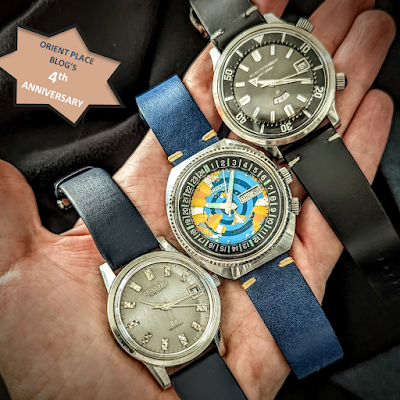What do you know? Another year has passed, and the blog now celebrating
its 4th anniversary! We're still running strong and not running out
of topics to write about, new watches to review, and old mysteries to uncover.
Time for our annual wrap-up then…
First, let's look at some stats. We've had about 122,000 views since the previous anniversary, a rise of 22% in traffic. Thank you, readers, followers, likers, sharers, and commenters! If the blog was trading on the stock exchange, our shares would be rocketing through the roof.
Thirty-five stories were posted in the last year, nearly three per
month. These included six hands-on reviews of current models, six reviews of
vintage or discontinued models, and five articles covering specific topics from
Orient's history.
I recently ran a survey on my Instagram account, a sort of popularity
contest between watches reviewed on the blog in the last year. Viewers voted
for their favorite among eight watches – five of the current models reviewed,
and three discontinued (but not particularly old) watches.
Lo and behold, the winner of the people's favorite: it's the Orient
Star Retrograde, which in the final battle managed to beat the World Map
re-issue with 60% of votes.
The most popular story of the last 12 months was the announcement of new "diver design" models, AKA "Kamasu 2", with over 3,000 views. Far behind, in second place was our hands-on review of the ever popular "World Map" re-issue with about 1,900 views, and in third place – the introduction of Orient's re-issues of the 1964 diver and the retro-future guitar. Generally speaking, then, it shows a major interest in the brand's new models! Well done, Orient.
The blog is active on social media: About 120 followers joined our
Facebook page last year, now totaling more than 660, and while my IG account
isn't solely about the blog, much of it does feature related content. The most
liked Orient watch pictures featured on my Instagram account were the Royal
Orient ref. WE0011EG (again... a photo of this beauty was also no. 1 in the previous
year!), the Orient Star Classic Semi-Skeleton, and a picture of the 1964 Diver.
Okay then, that was all about last year. What now?
As Orient continues to produce new models, we'll try to keep up. There
are a number of new models lined up to launch in the coming months, and there are
also watches awaiting their turn for a hands-on review, which in the best
tradition of the blog promises to be practical and insightful.
At the same time, we'll continue to take occasional plunges into the
brand's history. I've collected plenty of old records and info, and have
specific topics in mind, which I'll be covering in the near future.
Thank you all for following the blog, and keep sending in questions and
providing feedback!







